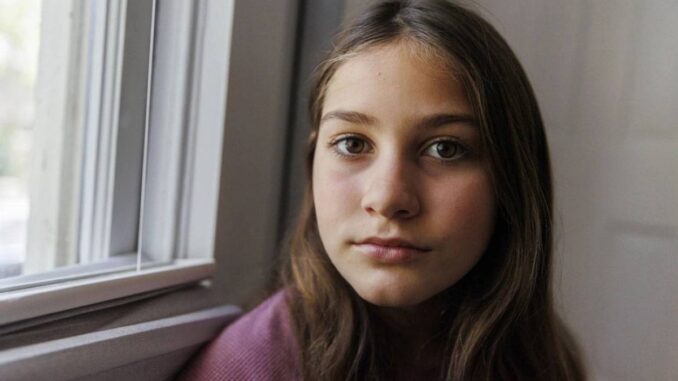
SACRAMENTO, California — When she was in fifth grade, Scarlett Goddard Strahan started to worry about getting wrinkles.
By the time she turned 10, Scarlett and her friends were spending hours on TikTok and YouTube watching influencers tout products for achieving today’s beauty aesthetic: a dewy, “glowy,” flawless complexion. Scarlett developed an elaborate skincare routine with facial cleansers, mists, hydrating masks and moisturizers.
One night, Scarlett’s skin began to burn intensely and erupted in blisters. Heavy use of adult-strength products had wreaked havoc on her skin. Months later, patches of tiny bumps remain on Scarlett’s face, and her cheeks turn red in the sun.
Scarlett Goddard Stratan, 11, poses for a portrait at her home on Tuesday, Aug. 20, 2024, in Sacramento, California. AP PHOTO
“I didn’t want to get wrinkles and look old,” says Scarlett, who recently turned 11. “If I had known my life would be so affected by this, I never would have put these things on my face.” Scarlett’s experience has become common, experts say, as preteen girls around the country throng beauty stores to buy high-end skincare products, a trend captured in viral videos with the hashtag #SephoraKids. Girls as young as 8 are turning up at dermatologists’ offices with rashes, chemical burns and other allergic reactions to products not intended for children’s sensitive skin.
“When kids use anti-aging skincare, they can actually cause premature aging, destroy the skin barrier and lead to permanent scarring,” says Dr. Brooke Jeffy, a Scottsdale, Arizona, dermatologist who has posted her own social media videos rebutting influencers’ advice.
More than the physical harm, parents and child psychologists worry about the trend’s effects on girls’ mental health — for years to come. Extensive data suggests a fixation on appearance can affect self-esteem and body image and fuel anxiety, depression and eating disorders.
The skincare obsession offers a window into the role social media plays in the lives of today’s youth and how it shapes the ideals and insecurities of girls in particular. Girls are experiencing high levels of sadness and hopelessness. Whether social media exposure causes or simply correlates with mental health problems is up for debate. But to older teens and young adults, it’s clear: extended time on social media has been bad for them.
Young girls’ fascination with makeup and cosmetics is not new. Neither are kids who hold themselves to idealized beauty standards. What’s different now is the magnitude, says Kris Perry, executive director of Children and Screens, a nonprofit that studies how digital media impacts child development. In an era of filtered images and artificial intelligence, some of the beautiful faces they encounter aren’t even real.
“Girls are being bombarded with idealized images of beauty that establish a beauty standard that could be very hard — if not impossible — to attain,” Perry says.
Saving allowances for Sephora hauls
The obsession with skincare is about more than the pursuit of perfect skin, explains 14-year-old Mia Hall.
It’s about feeling accepted and belonging to a community that has the lifestyle and look you want, says Mia, a New Yorker from the Bronx.
Skincare was not on Mia’s radar until she started eighth grade last fall. It was a topic of conversation among girls her age — at school and on social media. Girls bonded over their skincare routines.
“Everyone was doing it. I felt like it was the only way I could fit in,” says Mia. She started following beauty influencers like Katie Fang and Gianna Christine, who have millions of young followers on TikTok. Some influencers are paid by brands to promote their products, but they don’t always mention that.
Mia got hooked on “Get Ready With Me” videos, where influencers film themselves getting ready — for school, for a night out with friends, packing for a trip. The hashtag #GRWM has over 150 billion views on TikTok.
“It’s like a trance. You can’t stop watching it,” Mia says. “So when they tell me, ‘Go buy this product’ or, ‘I use this and it’s amazing,’ it feels very personal. Getting what they have makes me feel connected to them.” Mia started saving her $20 weekly allowance for trips with friends to Sephora. Her daily routine included a face wash, a facial mist, a hydrating serum, a pore-tightening toner, a moisturizer and sunscreen. Most were luxury brands like Glow Recipe, Drunk Elephant or Caudalie, whose moisturizers can run $70.
“I get really jealous and insecure a lot when I see other girls my age who look very pretty or have an amazing life,” she says.
Products promoting youth, purchased by kids. The beauty industry has been cashing in on the trend. Last year, consumers under age 14 drove 49 percent of drug store skin sales, according to a NielsonIQ report that found households with teens and tweens were outspending the average American household on skin care. And in the first half of 2024, a third of “prestige” beauty sales at stores like Sephora, were driven by households with tweens and teens, according to market research firm Circana.
The cosmetics industry has acknowledged certain products aren’t suitable for children but has done little to stop kids from buying them. Drunk Elephant’s website, for example, recommends kids 12 and under should not use their anti-aging serums, lotions and scrubs “due to their very active nature.” That guidance is on the site’s FAQ page; there are no such warnings on the products themselves.
Sephora declined to comment for this story.
Ingredients like retinol and chemical exfoliants like hydroxy acids are inherently harsh. For aging skin, they are used to stimulate collagen and cell production. Young or sensitive skin can react with redness, peeling and burning that can lead to infections, acne and hypersensitivity if used incorrectly, dermatologists say.
Dermatologists agree a child’s face typically needs only three items, all found on drugstore shelves: a gentle cleanser, a moisturizer and sunscreen.





Be the first to comment